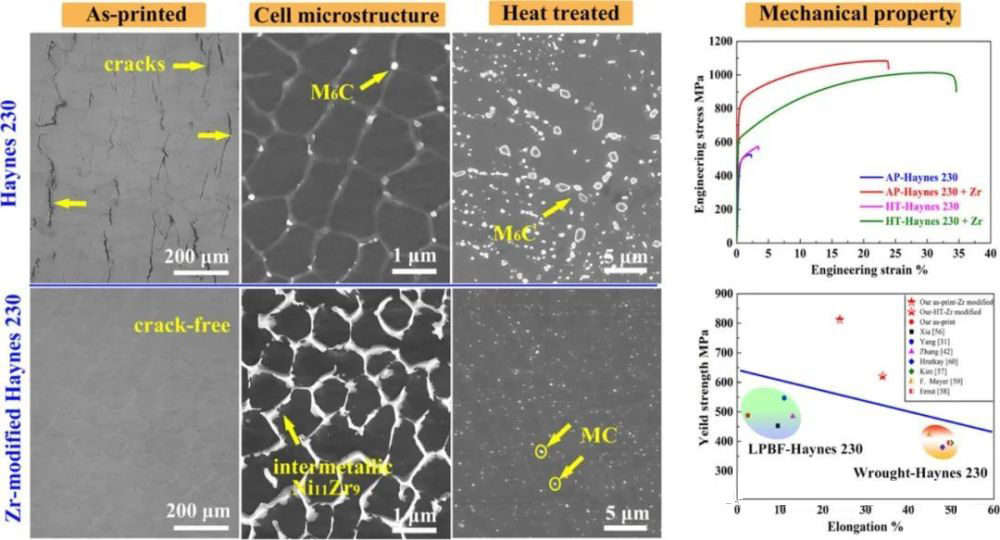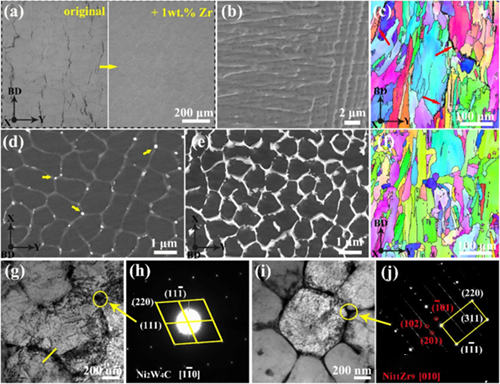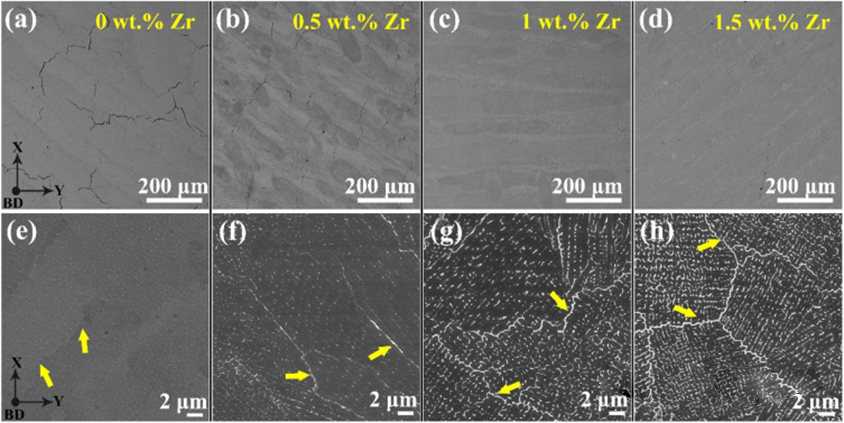phone:联系人:
13714630748(白先生)
18124150753(王先生)
屏幕修复专线:13145848466(潘生)
fax:0755-85279156
mailbox:ckdseiki@126.com
address:Meicheng Industrial Park, Langjing Road, Dalang Street, Longhua District, Shenzhen
A new way! Suppression of hot crack in nickel base superalloy in laser additive manufacturing
2023-04-08
Metal additive manufacturing, also known as metal 3D printing technology, has huge advantages over traditional manufacturing techniques for reducing materials in terms of complex integral component manufacturing, lightweight engineering and material utilization. However, this new technique has only been used in a few commercial alloys such as 316L, IN718, Ti6Al4V and AlSi10Mg. To achieve widespread application of metal additive manufacturing in alloys, the first challenge to be overcome is the manufacture of defect-free components. Most alloys do not adapt to the large temperature gradient caused by rapid cooling during laser additive manufacturing, and even some alloys with good weldability, such as Hastelloy X and Haynes 230, will exhibit severe cracking under thermal stress. This kind of crack is mainly represented by thermal crack, also known as solidification crack in casting, which generally occurs at the end of solidification of molten pool. It is generally believed that the thermal crack is caused by the segregation of elements, which leads to the expansion of the solidification range of the alloy and the formation of liquid film, which prevents the dendrite bonding. There is a synergistic effect between the liquid film and the thermal stress generated during the cooling and shrinkage of the alloy, which further promotes the stress concentration and eventually leads to the thermal crack.
Avoiding crack formation to ensure printing performance and good stability has always been a hot topic in the field of alloy additive manufacturing. Most of the previous studies focused on reducing the formation rate of liquid film and narrowing the solidification range of alloy. This work started with the segregation of elements and innovatively introduced the liquid film evenly into the dendrites at the end of solidification to achieve liquid backfill, release residual stress, relieve stress concentration and eliminate thermal cracks. Taking Ni-based superalloy as an example, in the process of laser additive manufacturing, Zr was introduced into the Ni-based superalloy to form a continuous intermetallic compound Ni11Zr9. When Zr content reached 1 wt%, Haynes 230 alloy without cracks was successfully printed. Surprisingly, this continuous Ni11Zr9 mesh layer was also found to act as a "skeleton", significantly improving the yield strength of printed samples. After proper heat treatment, the Zr-modified Haynes 230 alloy exhibits much better strong plasticity than the pre-modified alloy. These findings provide a new design idea for laser additive alloys with excellent mechanical properties and without cracks.
The team of Professor Liu Yongchang, Tianjin University entitled "New alloy design approach to inhibiting hot cracking in laser additive manufactured nickel-based" superalloys "was published in the internationally renowned journal Acta Materialia.
Link to paper:
https://doi.org/10.1016/j.actamat.2023.118736

Graphical abstract

Figure 1. (a) OM images of the original (0 wt% Zr) and Zr-modified Haynes 230 (1 wt% Zr) samples manufactured by LPBF along the print direction (BD). (b) Cell characteristics on the fracture surface confirm the thermal crack in the original sample. Microstructure characteristics of the original Haynes 230 sample: (c) EBSD reverse pole diagram (IPF), along BD, showing crack propagation along the columnar grain boundary, as shown by arrow; (d) nanoparticles aggregated at grain boundaries; (g) open field TEM image; (h) The SAED figure C particle of Ni2W4 is shown in (g). Microstructure of Zr-modified Haynes 230 samples: (e) continuous network precipitation and aggregation at grain boundaries; (f) EBSD IPF diagram along BD; (i) bright-field TEM images of coagulated cells; SAED pattern of intermetallic compound Ni11Zr9 phase shown by (j)-(i).

FIG. 2. OM and SEM images of Haynes 230 samples manufactured by LPBF: (a, e) 0 wt%Zr; (b, f) 0.5wt. % Zr; (c, g) 1 wt% Zr and (d, h) 1.5 wt% Zr.
In this work, segregation engineering is innovatively used to introduce a continuous uniform interdendrite liquid film at the end of solidification and eliminate the thermal crack in laser additive manufacturing. This strategy essentially takes advantage of the low partition coefficient of Zr in nickel-based superalloys to form a continuous and stable liquid film at the cell and grain boundary to achieve liquid backfill and relieve stress concentration. The ability of the process to eliminate thermal cracks was evaluated and the formation of network intermetallic compounds at the cells and grain boundaries of printed samples was investigated. Subsequently, M6C-to-MC was characterized systematically by the dissolution of intermetallic compounds and the refinement and transformation of intercrystalline carbides. Finally, the mechanical properties of the final sample are tested and compared with previously reported samples.

图3. (a, b) SEM图像分别展示了原始和Zr改性Haynes 230样品的热处理微结构。(c) TEM图像显示纳米沉淀物均匀分布。(d) TEM图像显示了(a)中的详细微观结构,其中M6C沉淀物聚集在晶界。(e) Ni、W、Cr、Zr、Mo和C的EDS图。(f)是(c)中显示ZrC颗粒的SAED

Figure 4. Stress-strain curves of Zr modified and original Haynes 230 samples after 3D printing and heat treatment. (b) Haynes 230 manufactured by LPBF, the traditional method and the method used in this study
This article is reproduced by author: Laser manufacturing network Source: additive manufacturing circle




